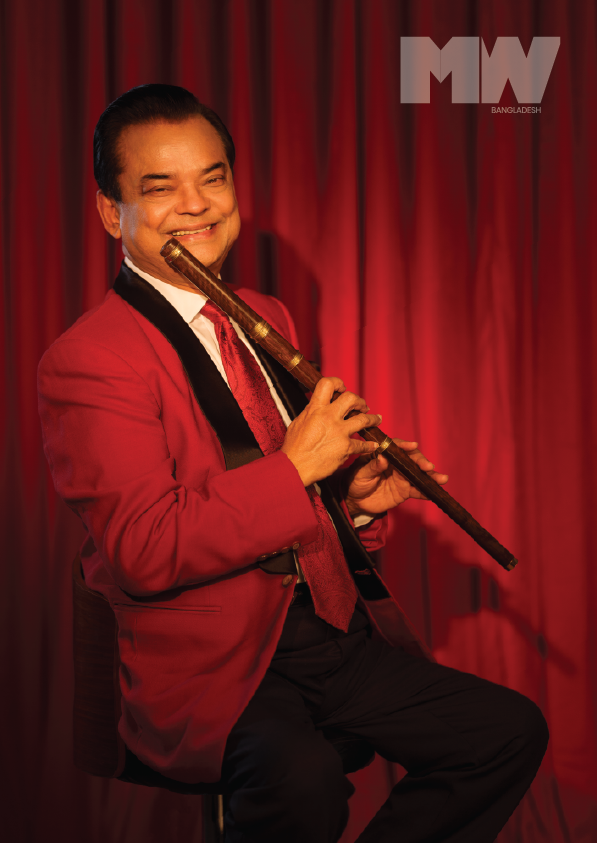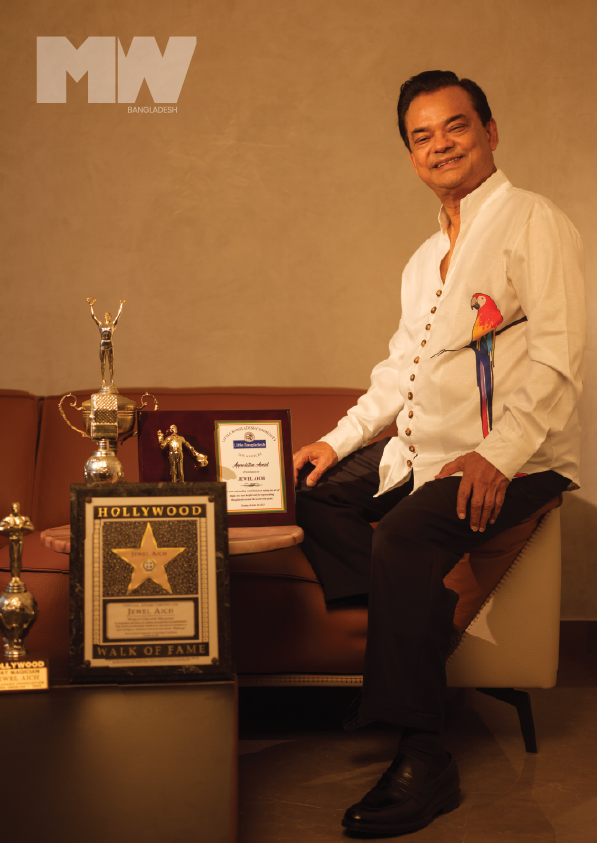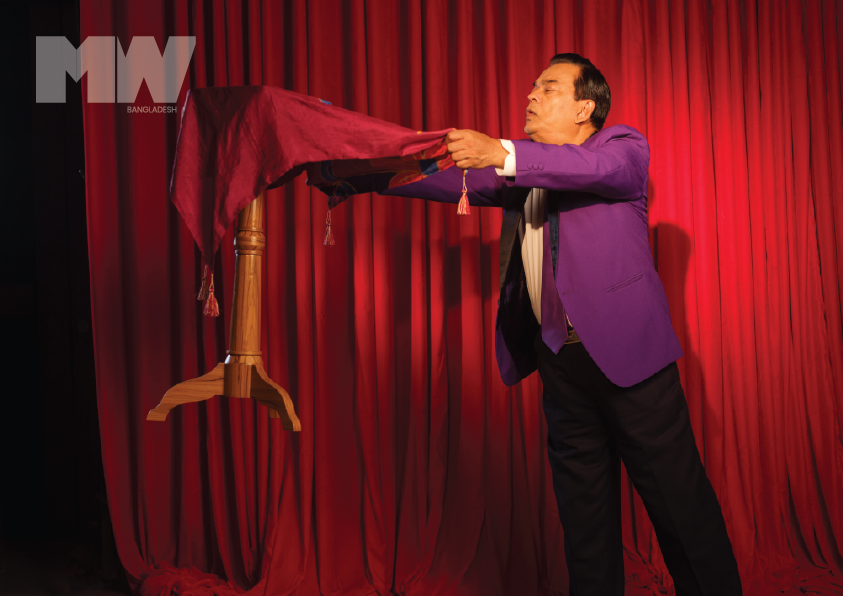He is a veteran of the Liberation War of 1971, he has devoted his life to charity, and he is a UNICEF National Ambassador. His creative side encompasses being an accomplished flutist as well as a visual artist. All of these things are indispensable aspects of his identity, but more than anything else, one thing springs to mind when the name Jewel Aich is mentioned: Magic. For over four and half decades, Jewel Aich has been front and center of the magic scene in Bangladesh. In fact, the word magician in this country might as well be replaced by a simple two-word synonym: Jewel Aich
By Abak Hussain
Ask a Bangladeshi person to name a compatriot magician, and ten times out of ten the answer, unless the respondent is being facetious, will be Jewel Aich. For the generation that came of age in the days before cable, internet, or widespread exposure, Jewel Aich was the very definition of magic. His TV specials, guest appearances, and stage shows punctuated day to day life in the country. What is miraculous though, is that in subsequent decades, his dominance of the national consciousness when it comes to magic has not faded in the least.
No other Bangladeshi magician of a later generation has managed to come even close to Jewel Aich’s reputation, let alone supersede it. To this date, Jewel Aich remains the only magician to have won the Ekushey Padak – one of the highest civilian honours in the country. His shelves overflow with awards and honours won over the years – too many to count. He has toured all over the world, performing for an audience of 2,000 at the Society of American Magicians in the United States, as early as 1981 as highlight of the closing night, but also in the tightly closed up, secretive regime of North Korea, which he visited upon the Kim Il-Sung government’s invitation.
Through all of this, Jewel Aich kept his heart at home, and over the course of his career he has likely toured all the districts of the nation, performing to sold-out crowds in venues ranging from large theatres to small, rural settings to underprivileged segments. He is, besides being a magician, a professional flautist, a visual artist, a UNICEF national ambassador since 2013, and a scholar of any and all subjects that interest him.
But perhaps at the core of all that he does, a subject that he comes back to over and over again in conversation, is the Liberation War of 1971. His role as a freedom fighter informs his life and work. The trauma and brutality of the war, and the ultimate victory over the Pakistani forces are unforgettable experiences for the magician. Whether speaking of art, science, literature, or religion, again and again, the veteran magician returns to his role as a veteran of 1971 – it seems to be his centre of gravity, and the rock upon which he has built his life, his career, his art.

The buzz the buzzsaw created
“I am a bit crazy, you understand,” says the master magician, after talking his way through a dizzying array of subjects, ranging from the history of the sub-continent in the days before Partition, to the Language Movement, the Liberation War, the history of science, the three major Abrahamic religions, as well as reciting off verses by heart, verses from Tagore, Nazrul, Sheikh Fazlal Karim, Iqbal, and others. “Whatever I have been drawn to, I have dived into – and once I picked up an interest, I stuck with it.” Clearly, Aich is not a man of pastimes and hobbies, he is a man of passions and obsessions.
In the drawing room of his home, in the aptly named Magic Castle – the naming no doubt a tip-of-the-hat to the most prestigious clubhouse of magic in the world, located in California – vintage posters from all around the world hanging on the wall bring back memories of his long and spectacular career. Here is Jewel Aich levitating his assistant high above his head, running a hoop around her to prove there are no strings or funny business. Here is one from around 20 years ago with his daughter Kheya, when Kheya was still a child – a sweet reminder that for Jewel Aich, magic has always been a collaborative experience with his immediate family. But the poster that stops me in my tracks is one from the late 1980s. It is a promotion for shows in various cities in the UK – Birmingham, Luton, Manchester. The featured photo is one so ingrained in the popular imagination of this country that it instantly takes me back to the heydays of the BTV specials.

It is the image of Jewel Aich driving an electric buzzsaw through his wife and partner-in-magic Bipasha Aich. Back when it first aired, the show raised heart palpitations and caused anxiety attacks. In this act, we see the magician introduce a menacing looking electric buzzsaw, its lethality proven by cutting a wooden stick in half. The saw is then, in full view of the spectator, driven through the assistant’s torso, and then a rectangular blade is put into the spot lest there was any doubt. There is pin-drop silence in the theater. Those watching on TV are also holding their breath. What if something goes wrong? Of course, Bipasha emerges unharmed, and the illusion ends with the pair taking a bow.
The buzz this performance created at the time is hard to imagine in a contemporary context where we are flooded with content on social media and YouTube. But back then, it was all anybody talked about for days. At school, my friends and I were fixated: How did he do that? And why would someone even try such a thing? Theories ran wild, but of course, none of us had a clue.

I ask him about the origin of the illusion. What was the thinking behind it? He explains to me a bit about the history of magic that led up to that concept. Right after the Second World War, there was a trend in magic to show dangerous or frightful things, such as sawing assistants in half. “The idea first came to a magician called PT Selbit, the British magician. He was the first to practically do this on stage. Not in this form, not the way I did it openly, he used to put his assistant in a box and then cut it in half. This was a long time ago, of course, mine would be more modernised. The idea itself, though, dates back at least 70 years before PT Selbit, going back to Robert-Houdin … Robert-Houdin’s influence was what caused magician Ehrich Weiss to change his name to ‘Houdini.’ Robert-Houdin can be called the ‘father of modern magic.’ Robert-Houdin made magic respectable, so to speak, performing to a well-dressed, educated audience.”
This fascinating chapter of magic history includes the account of Robert-Houdin, way back in 1856, being dispatched by the French government to Algeria to fight the influence of the Marabout – something akin to a miracle cult.

Aich’s attraction to danger and the macabre was not limited to the iconic buzzsaw performance, however. In many districts through the country, he performed the effect of stopping the human pulse, once in this wrist, then in that wrist. Then in both wrists. Then came a grisly tongue-slicing effect. In show after show, audiences fainted. The show was so grotesquely powerful it was too much for some to handle. The overall effect put Aich at unease. “Is this still entertainment?” he asked himself, thinking about the shock it caused in the audience. The capsize point was when a very large man, a village “boro bhai” type went up on stage and collapsed during the tongue-cutting with a resounding thud, causing a domino effect of a number of others in the audience to faint. The magician was laser-focused on the task at hand, so there was not much he could do when he heard the volunteer on stage say “dhor, tora amare dhor” (hold me up so I don’t fall) before collapsing. “On that same day, I decided to not do this performance anymore,” Aich recalls.
Tight spots, narrow escapes
Many will remember the Jewel Aich illusion where the master is tightly bound up by volunteers and then placed inside a trunk and locked up. He then escapes. It is no surprise that like many magicians around the world, Aich has a taste for this narrative. What may be less obvious though, is that in real life, many times he has found himself in close scrapes, and has had to escape using his wits and his ingenuity. Those unscripted narrow escapes form a powerful narrative thread in his life. Like an expert raconteur, he takes us on a tour of his treasured memories.
He talks about the time residents of rural areas were being afflicted with an inexplicable mental illness. Medical science knew it was schizophrenia. “We started reading up about schizophrenia, mental illness. Mostly magazines that came to us from West Bengal, then there was the 12-volume set on criminology in the public library. We searched for literature on jinns, or ghosts. We studied the consequences for schizophrenia patients. Armed with this knowledge, we started campaigning against the ojhas (supernatural healers).” In one of his debunking missions with his comrades, he was beaten up by the fraudulent party, and was lucky to escape.

At one point he launches into the harrowing story about the time he almost lost his leg: “In 1971 … you know, we were raised in the city, so we got gangrene in our legs. Around evening, after returning home through the mud, I noticed red marks everywhere. Then I saw the wound under my foot. We didn’t have the medicine. I suggested burning the wound, and various treatments … we used to walk 350 miles by foot, we had rifles slung around our shoulders, so we couldn’t go by launch or take the main road.” They walked through jungles, Pirojpur to Bagerhat to Khulna to Jessore to Satkhira and on and on. Eventually in Hasnabad, after three days, the men there, seeing the state of Aich’s foot sent him to a hospital, and there a few senior doctors said the foot should be cut off, the gangrene had travelled far. But a young doctor gave injections to test sensation, and asked to hold off on the amputation. He suggested to the young Jewel Aich to tell the doctors he would not consent to the amputation – no way. The wound was below the knee, which was good, and the young doctor believed antibiotics would eventually cure the foot. The senior doctors were furious at him for this contrary advice. Aich refused to sign the consent form for amputation, and the rest is history. Thankfully for all of us, he did not lose his leg that day, and was able to go on to have a long career as a stage magician, all limbs intact.
Then there are the more light-hearted predicaments. Once, after asking for volunteers who wished to be levitated, a man of large girth came up on stage. “I knew I could levitate him, but the part I didn’t quite account for beforehand … well … once he was levitated, naturally my assistant handed me the hoop (to prove there was no support). I looked at the hoop – it was solid, but I never imagined I would have to run such a large potbellied man through it. I started from the head and when I passed the hoop down to his chest, well, it got stuck. Now try to understand my predicament! If I backtrack, then my 2,000 audience members will think there’s something wrong. So in the end, bit by bit, pressing here and there, once left, once right, I was able to pass the hoop. The audience were screaming so loud, throughout! The floating volunteer had his hand on his tazbi, and was reading suras. I had to tell him to lower his hand.” A close shave, a bit of inadvertent comedy, but crisis averted.

Magic in the moonlight
Jewel Aich’s interests are so diverse, so eclectic, I ask him what goes on behind developing a new magic trick or illusion. “Multiple things,” he says. “Let’s say, I want to pass a message. For example, to make a point to combat violence against women. In order to do that, I need an act. So I constructed a prison-like structure, and there we trap a woman, tied up. There’s a curtain in the front. Then in one sweep, the curtain falls to the stage, and the muscular man upfront is now trapped inside, and the woman has been liberated, and she is smiling. Through the presentation of the act, I link the message. The magic is baffling, but through it I want to make a statement. I have magic, for example, against communalism. So these are things that start with an idea and then … how can I execute this in a believable way?”
He explains that sometimes there are puzzles or images that serve as new magic. Optical illusions which can sometimes be seen on social media today can give impetus for a new effect. Other haunting images or moods from life stick to his mind: “I was once on a steamer. First there were clouds, then a storm, then the dark clouds obscured the moon, and when the clouds moved away the moon reappeared. The waves were getting violent.”
I ask him if he has a favourite among the various magical genres, his performances have been so across the board, from sawing, to levitation, to card tricks. Does he have a preference? “If you mean genre, then it’s a type of magic. If I float a needle, or if I float a girl on stage, both are levitation. Floating is my favourite genre. Even with still cameras you can understand floating. I once levitated the singer Kona, on a thin carpet. She lay down on the carpet … It was an Anandamela program. Then slowly, the carpet rose. Then I passed a hoop to prove there was no support. Then the carpet rose further, up above my head. Kona was amazed, the audience was amazed, and I was delighted.” Then of course, there was the earlier-mentioned story of the large man who got stuck in the hoop. “I like any type of levitation,” he says, mentioning an act called Jhoro Akashe Purinmar Chad, inspired by the image of the disappearing moon he saw on that steamer. “A round moonlike thing appears, but just floating up isn’t enough, it floats in various directions, then I hold a black cloth, resembling a dark cloud, and the moon peeks through, then hides … like the full moon I had witnessed. I see something, or think about something, or perhaps take a puzzle and hold it in my mind, or take a scientific truth, and then use it in the magic.”

I ask him about the future of magic. Technology has changed, the world has changed, we live in a world of YouTube and smartphones. The audience has changed. How has he experienced this change over the years? Where does he see it all going? “If you can’t always evolve with the times and move ahead, then nothing can endure … There was a time when Rabindrasangeet was not popular at all, now it is highly popular. The words and the music have risen again. Nazrulgeeti has not declined at all. So … only time will tell for sure what will endure and what won’t. But you have to evolve, so I have always tried to move forward. The magic I do now … I am already readying what I will do five years in the future.”
I mention the recent popularity of close-up magic, and sneak in a reference to David Blaine. He is quick to tell me close-up magic was always extremely popular. “Blaine in a sense was a reaction against the likes of David Copperfield, who went for larger and larger illusions, disappearing the Statue of Liberty, disappearing trains. So David Blaine did his 180-turn forging his role as a street magician, wearing an ordinary t-shirt, jeans, sneakers. That was his persona, his role as a ‘street magician,’ doing mostly close-up. But long, long before David Blaine, in the Magic Castle [in the United States], there was a place called the Close-up Gallery where only close-up was performed. I have performed close-up since I was young, but since I have a large audience, I have to pay attention to who is sitting far away, so that they don’t get deprived. I won’t perform the kind of magic where only the people sitting up front can see, and those at the back can’t. That is why my magic that you see mostly tends to be large … Back in the day, on television I did a series on the history of magic, about how since the days of the pyramids there was magic, and have done close-up magic from those times. For me, no magic is ‘bad’ but since you asked I said I like floating. And here’s the thing. Let’s say I disappear something, if I do it on stage, or I can be cuffed and put in a box. So the next day I would see photos in the newspapers, and audiences wouldn’t understand it from the picture. But when there is a picture of a girl floating in mid-air, then there is nothing left to say to explain what is happening. From that time onwards, I have been partial to levitation.”

A life of charity
Jewel Aich is a man of free associations, insightful digressions, and a life rich in memories that flow out of him. Even though magic is by far what he is most famous for, it is clear that magic is a mere fraction of what drives him. He has a passion for his country that does not seem to bow to petty politics at all, but is genuinely focused on the interests of his fellow men and women.
We spoke for hours on end, but even that seemed like the tip of the iceberg. I learn a fact towards the end of our talk which suddenly illuminates everything that he says: 50% of his shows have been for charity. Again and again, he performs for those who would never otherwise witness a world class magician up front.
As UNICEF ambassador, he has promoted the health, safety, and wellbeing of children. Even though he has performed all over the world, and would have had a residency in the flashiest venues in foreign cities if he so wished, he has always made his home, his own castle, right here in Dhaka among his people. Now, in his 70s, he is as undaunted as ever, whatever the challenge.
“I mean, if we were able to beat those guys back in 1971 …” he starts again, with a deep, hopeful breath.














